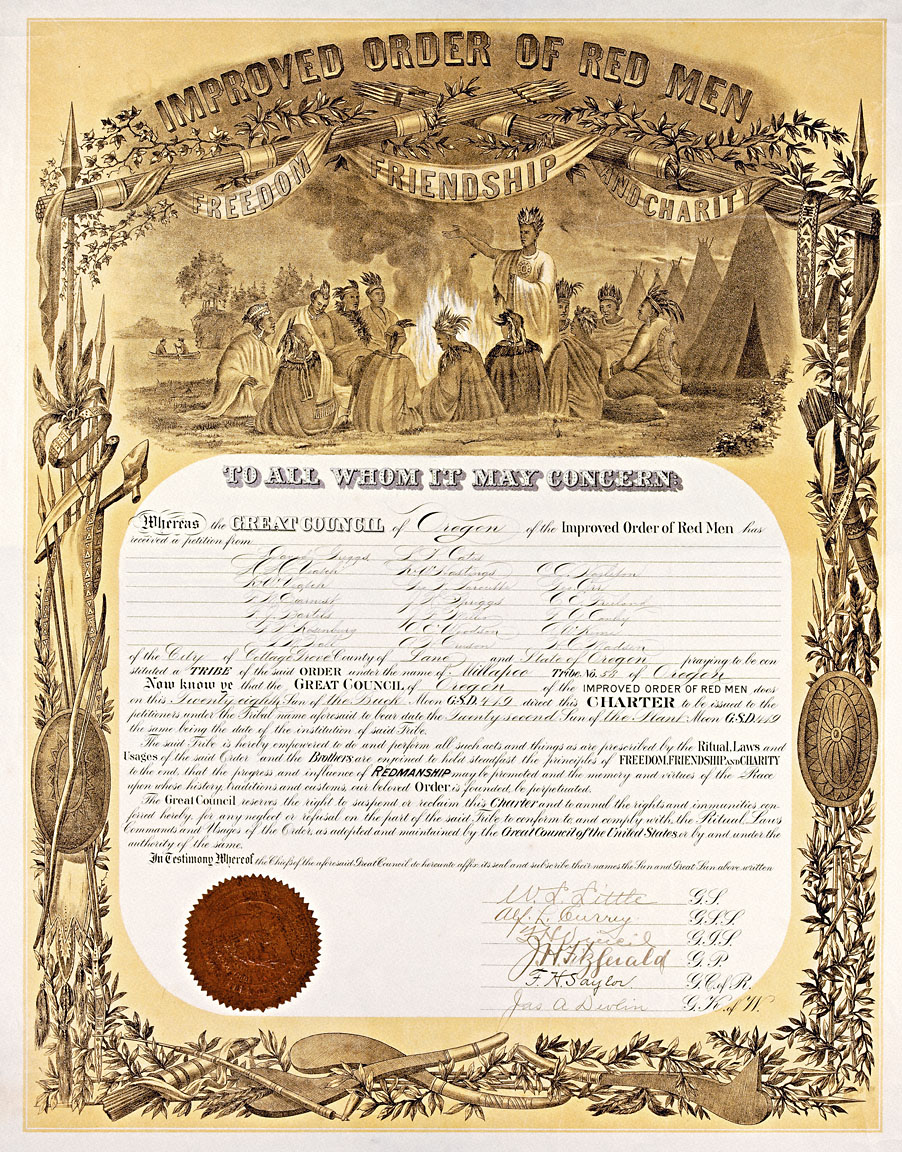- Catalog No. —
- Mss 1501
- Date —
- July 28, 1910
- Era —
- 1881-1920 (Industrialization and Progressive Reform)
- Themes —
- None
- Credits —
- Oregon Historical Society
- Regions —
- Willamette Basin
- Author —
- Improved Order of Red Men
Charter for Millapoo Tribe Number 58
This certificate of charter officially organized the Milapoo Tribe No. 58 of the Improved Order of Red Men (IORM), a franternal society from Cottage Grove. The charter was granted on the “28th Sun of the Buck Moon G.S.D 419” (July 28, 1910) and back-dated to the date of the “tribe’s” formation, “the 22nd Sun of the Plant Moon G.S.D 419” (April 22, 1910). As the dating of the charter indicates, the IORM created a pseudo-Indian vocabulary and calendar to describe their affairs and used it to record their own history. A “sun” is a day; a “moon” is a month; and “G.S.D.” is an acronym for “Great Sun of Discovery,” used to code years by starting at zero from 1491—Columbus’s voyage. Only white men could be “adopted” as tribal members of the IORM.
The organizational identity of the IORM draws heavily upon the patriotic heritage of the American Revolution and the early years of the republic, claiming to have evolved directly from the Sons of Liberty—the infamous rebels of Boston Tea Party fame—and anti-British Saint Tamina Societies of the Northeast. The most direct predecessor of the IORM was the Society of Red Men, which formed in 1813 and suffered declining numbers during the 1820s and early 1830s as the American public’s popular opinion leaned heavily against secret societies and their intemperance. In 1834, a group of Baltimore Red Men reorganized their “tribe” away from political action and focused their fraternity into a mutual benefit society. They changed their name to the Improved Order of Red Men a year later as a reflection of their improved temporant status. Still in existence today, the IORM is the oldest homegrown fraternal society in the United States.
In 1871, Oregonian-Pocahontas Tribe No. 1, Oregon’s first IORM tribe, formed in Jacksonville. From the 1870s through the 1920s, at least sixty-five more tribes were formed in Oregon, but economic troubles during the depressions of the mid-1890s and the 1930s caused their numbers to decline precipitously. By 1936, only three tribes remained in Oregon: Willamette Tribe No. 6 (Portland), Showaway No. 49 (Umatilla), and Weatonka No. 1 (Medford). After the charter was revoked from the “Great Council of Oregon” in December 1935, the three remaining tribes were taken under the jurisdiction of the “Great Council of the United States.” By 1960, only Medford’s Weatonka Tribe remained, and it was subsequently taken under the jurisdiction of the “Great Council of California.” Today, they remain the only IORM tribe in Oregon.
Further Reading:
Knobel, Dale T. “To Be An American: Ethnicity, Fraternity, and the Improved Order of Red Men.” Journal of American Ethnic History 4, 1984: 62–87.
Deloria, Philip J. Playing Indian. New Haven, Conn., 1998.
Written by Joshua Binus, © Oregon Historical Society, 2006.
